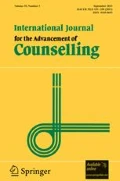Abstract
This article reviews the statistical evidence of LGBT violence in the United States and in the world. In the United States the statistics are from Amnesty International and the New York City Gay and Lesbian Anti-Violence Project. Statistics and other information about LGBT violence in other countries of the world come from many different sources. Reasons why this violence exists and international human rights responses are reviewed. The authors argue for a greater role for mental health organizations in the amelioration of prejudice against LGBT people and for more involvement of these organizations in social justice issues around the world. The article concludes with recommendations for future directions.
Similar content being viewed by others
References
American Psychological Association. (2000). Guidelines for psychotherapy with lesbian, gay, and bisexual clients. American Psychologist, 55(12), 1440-1451.
American Psychological Association. (1999). Answers to Your Questions About Sexual Orientation and Homosexuality: Definition of sexual orientation. Washington, DC: Author. Retrieved May 10, 2003, from http://helping.apa.org/daily/answers.html
Amnesty International. (2001). Crimes of hate, conspiracy of silence. Oxford, United Kingdom: The Alden Press.
Berrill, K. T. (1992). Anti-gay violence and victimization in the United States: An overview. In G. M. Herek & K. T. Berrill (Eds.), Hate crimes: Confronting violence in lesbians and gay men (pp. 19-45). Newbury Park, CA.: Sage.
Boxer, A. M., & Carrier, J. M. (1998). Evelyn Hooker: A life remembered. Journal of Homosexuality, 36 (1), 1-17.
Committee on Lesbian and Gay Concerns. (1991). Avoiding heterosexual bias in language. American Psychologist, 46 (9), 973-974.
Cong, Z., & Wu, J. (1998). Open debate in China. American Psychological Association Divion 44 Newsletter, 14(1). Retrieved May 10, 2003, from http://www.apa.org/divisions/div44/open.html
D'Augelli, A. R. (1998). Developmental implications of victimization of lesbian, gay, and bisexual youth. In G. M. Herek (Ed.), Stigma and sexual orientation: Understanding prejudice against lesbians, gay men, and bisexuals (pp. 187-210). Thousand Oaks, CA: Sage.
De Angelis, T. (2002). Bringing LGB issues to the international stage. APA Monitor on Psychology, 33(2), 51.
Di Placido, J. (1998). Minority stress among lesbians, gay men, and bisexuals: A consequence of heterosexism, homophobia, and stigmatization. In G. M. Herek (Ed.), Stigma and sexual orientation: Understanding prejudice against lesbians, gay men, and bisexuals (pp. 138-159). Thousand Oaks, CA: Sage.
Drescher, J. (1998). I'm your handyman: A history of reparative therapists. Journal of Homosexuality, 36(1), 19-42.
Fowers, B. J., & Richardson, F. C. (1996). Why is multiculturalism good? American Psychologist, 51(6), 609-621.
Ferreira, E. (2000, January 26). S. Africa-law: S. Africa passes landmark bill to outlaw discrimination. Agence France-Presse Retrieved May 10, 2003, from http://ww2.aegis.org/news/afp/2000/AF000138.html
Gauch, S. (2002, March 1). Egypt cracks down on gays, trumping Islamists. Christian Science Monitor, p. 7.
Glaser, J., Dixit, J., & Green, D. P. (2002). Studying hate crime with the Internet: What makes racists advocate racial violence? Journal of Social Issues, 58(1), 177-193.
Gorman, W. (2001). Refugee survivors of torture: Trauma and treatment. Professional Psychology: Research and Practice, 32(5), 443-451.
Halprin, L. (1997). The Franklin Delano Roosevelt Memorial. San Francisco, CA: Chronicle Books.
Harry, J. (1990). Conceptualizing anti-gay violence. Journal of Interpersonal Violence, 5(3), 350-358.
Herek, G. M. & Berrill, K. T. (Eds.) (1992). Hate crimes: Confronting violence against lesbians and gay men. Newberry Park, Ca.: Sage.
Hong, W., Yamamoto, J., Chang, D. S., & Lee, F. (1993). Sex in a Confucian society. Journal of the American Academy of Psychoanalysis, 21(3), 405-419.
Kimmel, D. C., & Yi, H. (in press). Characteristics of Gay, Lesbian, and Bisexual, Asians, Asian Americans, and Immigrants from Asia to the US. Journal of Homosexuality.
Lingiardi, V., & Drescher, J. (Eds.). (2003). The mental health profession and homosexuality: International perspectives. Binghamton, New York: Haworth Press.
Marsella, A. J. (2000). Internationalizing the psychology curriculum: Toward new competencies and directions. International Psychology Reporter, 4(3), 1-4.
Nakajima, G. A., Chan, Y. H., & Lee, K. (1996). Mental health issues for gay and lesbian Asian Americans. In R. P. Cabaj & T. S. Stein (Eds.), Textbook of homosexuality and mental health (pp. 563-582). Washinton DC: American Psychiatric Press, Inc.
New York City Gay and Lesbian Anti-Violence Project. (2001). A report of the national coalition of anti-violence programs. New York: National Coalition of Anti-Violence Programs.
Ryam, C., & Futterman, D. (1998). Lesbian and gay youth: Care and counseling. New York: Columbia University Press.
Savin-Williams, R. C. (1994). Verbal and physical abuse as stressors in the lives of lesbian, gay male and bisexual youths: Associations with school problems, running away, substance abuse, prostitution, and suicide. Journal of Consulting and Clinical Psychology, 62(2), 261-269.
Shidlo, A., Schroeder, M., & Drescher, J. (Eds.). (2002). Sexual conversion therapy: Ethical, clinical, and research Perspectives. New York: Haworth Press.
Simon, A. (1998). The relationship between stereotypes of and attitudes toward lesbians and gays. In G. M. Herek. (Ed.), Stigma and sexual orientation: Understanding prejudice against lesbians, gay men, and bisexuals. Psychological perspectives on lesbian and gay issues, Vol. 4. (pp. 62-81). Thousand Oaks, CA: Sage.
Sohng, S., & Icard, L. D. (1996). A Korean gay man in the United States: Toward a cultural context for social service practice. Journal of Gay and Lesbian Social Services, 5(2/3), 115-137.
World Health Organiztion. (1992). International statistical classificaiton of diseases and related health problems (10th rev.). Geneva: Author.
Yi, H. (2002, July). Online censorship and its impact on LGBT community: A response to Korea's Internet content filtering ordinance. Presented at the 52nd International Communication Association Conference, Seoul, Korea.
Author information
Authors and Affiliations
Rights and permissions
About this article
Cite this article
Dworkin, S.H., Yi, H. LGBT Identity, Violence, and Social Justice: The Psychological Is Political. International Journal for the Advancement of Counselling 25, 269–279 (2003). https://doi.org/10.1023/B:ADCO.0000005526.87218.9f
Issue Date:
DOI: https://doi.org/10.1023/B:ADCO.0000005526.87218.9f




